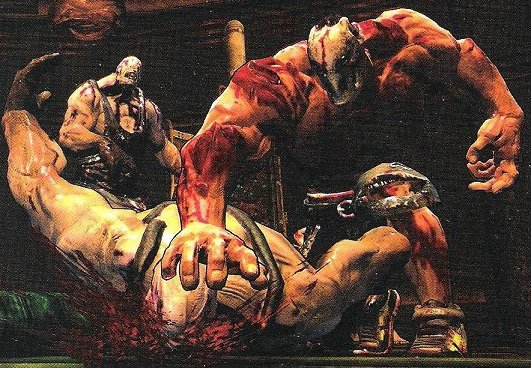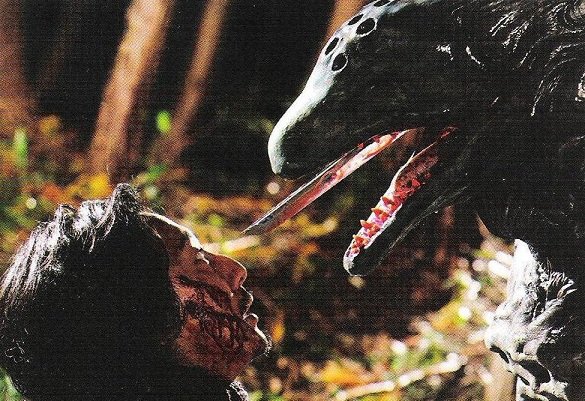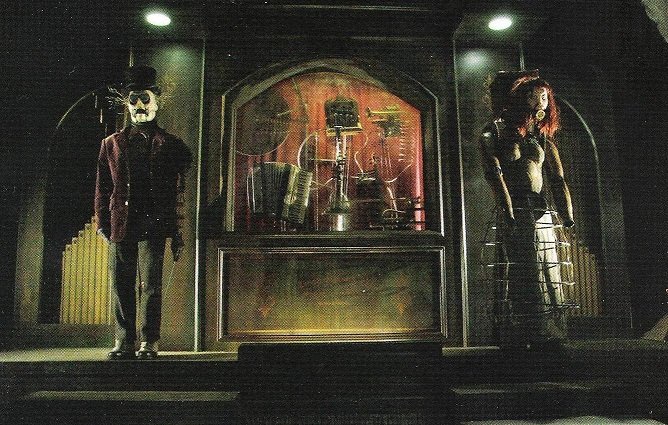NUEVO FANGO: Part 2 - Issue #295
When it was announced that Fangoria was changing editors, part of the announcement involved the idea that the focus of the magazine would be broadened from just horror films to more of a horror "lifestyle" focus. This prompted a sense of dread in many horror fans, as they are a cultish lot and don't like the idea of their genre passion being reduced to yet another commodity that can be bought and sold. This is understandable - Your Humble Reviewer is not crazy about that kind of marketing speak being thrown around. However, this type of broadening doesn't seem to have hurt Fangoria when you look at its specific application. For an example, consider the cover story of Issue #295 - it's devoted to a look at the latest incarnation of Splatterhouse, a video game that has been delighting and disgusting horror fans in several incarnations since the 1990's. This piece covers the history of the game as well as the technical particulars involved in designing such a game. Its value is further enhanced by a brief but excellent history of horror gaming, starting with the Atari 2600 and going all the way to the present. Both pieces are written in a way that is appealing
However, this type of broadening doesn't seem to have hurt Fangoria when you look at its specific application. For an example, consider the cover story of Issue #295 - it's devoted to a look at the latest incarnation of Splatterhouse, a video game that has been delighting and disgusting horror fans in several incarnations since the 1990's. This piece covers the history of the game as well as the technical particulars involved in designing such a game. Its value is further enhanced by a brief but excellent history of horror gaming, starting with the Atari 2600 and going all the way to the present. Both pieces are written in a way that is appealing  even for those not interested in video gaming - if you have a scholarly interest in horror history, there's worthwhile material to be gleaned from these articles.Elsewhere, Issue #295 is devoted to the familiar roundup of articles on new and forthcoming horror films. There are a few of the expected mainstream-oriented titles - a short visit to the set of Predators, another visit to the set of the new season of True Blood - but the majority of the issue deals with more offbeat forms of horror filmmaking. For instance,
even for those not interested in video gaming - if you have a scholarly interest in horror history, there's worthwhile material to be gleaned from these articles.Elsewhere, Issue #295 is devoted to the familiar roundup of articles on new and forthcoming horror films. There are a few of the expected mainstream-oriented titles - a short visit to the set of Predators, another visit to the set of the new season of True Blood - but the majority of the issue deals with more offbeat forms of horror filmmaking. For instance,  there's an article on Sushi Typhoon, a Japanese company that seeks to overcome Japan's indifference to horror by making films aimed at a worldwide marketplace, and a preview of the uber-controversial A Serbian Film. The latter piece is particularly amusing because of how the filmmakers strain to find social and political justifications for their work to dodge the film's inevitable "torture porn" label.An interesting element within the coverage of up-and-coming films is how it spotlights the unique methodology and personalities behind these efforts. For instance, an article on Salvage, a low-budget effort from England, involves some discussion of how the film managed to get funding through a government-sponsored film funding initiative. Also, a piece on a 2001 Maniacs sequel is livened up by a sidebar interview with Kevin Ogilvie that finds this musician/actor discussing his
there's an article on Sushi Typhoon, a Japanese company that seeks to overcome Japan's indifference to horror by making films aimed at a worldwide marketplace, and a preview of the uber-controversial A Serbian Film. The latter piece is particularly amusing because of how the filmmakers strain to find social and political justifications for their work to dodge the film's inevitable "torture porn" label.An interesting element within the coverage of up-and-coming films is how it spotlights the unique methodology and personalities behind these efforts. For instance, an article on Salvage, a low-budget effort from England, involves some discussion of how the film managed to get funding through a government-sponsored film funding initiative. Also, a piece on a 2001 Maniacs sequel is livened up by a sidebar interview with Kevin Ogilvie that finds this musician/actor discussing his  friendship with the now-deceased Forrest Ackerman in emotionally wrenching detail. Even more interesting is the case of Parasomnia, a film made by horror vet William Malone as a passion project after spending the last several years toiling away on restrictive major studio television and film projects (he even financed it himself).The appeal of the latter piece is further enhanced by a sidebar article about Malone's career. Editor Chris Alexander wrote this piece and it is fueled by a passion to sell the reader on the work of a director he believes is underappreciated amongst genre fans. This
friendship with the now-deceased Forrest Ackerman in emotionally wrenching detail. Even more interesting is the case of Parasomnia, a film made by horror vet William Malone as a passion project after spending the last several years toiling away on restrictive major studio television and film projects (he even financed it himself).The appeal of the latter piece is further enhanced by a sidebar article about Malone's career. Editor Chris Alexander wrote this piece and it is fueled by a passion to sell the reader on the work of a director he believes is underappreciated amongst genre fans. This  kind of personal touch goes a long way towards making the magazine look less corporate and more fan-orientated. Your Humble Reviewer doesn't know if this is a savvy business strategy but it's definitely the kind of thing that will appeal to the genre enthusiast.The issue also continues the magazine's renewed interest in horror's past. This comes through most strongly in two particular pieces. The first is a preview of American Grindhouse, a documentary about the history of exploitation cinema. It's an intereview with director Elijah Drenner: his passion for his work is easy to appreciate but he takes a detour into pretension when he goes off on a lecture about how it isn't really right to refer to these films as "grindhouse movies" (not the most advisable step to take when your documentary is called American Grindhouse). More appealing is an interview with Lynn Lowry, veteran star of films like The Crazies and They Came From Within. It
kind of personal touch goes a long way towards making the magazine look less corporate and more fan-orientated. Your Humble Reviewer doesn't know if this is a savvy business strategy but it's definitely the kind of thing that will appeal to the genre enthusiast.The issue also continues the magazine's renewed interest in horror's past. This comes through most strongly in two particular pieces. The first is a preview of American Grindhouse, a documentary about the history of exploitation cinema. It's an intereview with director Elijah Drenner: his passion for his work is easy to appreciate but he takes a detour into pretension when he goes off on a lecture about how it isn't really right to refer to these films as "grindhouse movies" (not the most advisable step to take when your documentary is called American Grindhouse). More appealing is an interview with Lynn Lowry, veteran star of films like The Crazies and They Came From Within. It  focuses on her recent comeback via various indie horror efforts and she comes off as likeably unpretentious and sincere about her work.The scholarly bent touched on in the above two pieces is continued elsewhere in the magazine via a series of short features that touch on specific films from the genre's past. For example, there are compelling one-page appreciations of films like Possession, Silver Bullet and the t.v. film Dead Of Night. There's also a fascinating piece about how the industrial group Coil almost did the score for Hellraiser: it works both as a cautionary tale
focuses on her recent comeback via various indie horror efforts and she comes off as likeably unpretentious and sincere about her work.The scholarly bent touched on in the above two pieces is continued elsewhere in the magazine via a series of short features that touch on specific films from the genre's past. For example, there are compelling one-page appreciations of films like Possession, Silver Bullet and the t.v. film Dead Of Night. There's also a fascinating piece about how the industrial group Coil almost did the score for Hellraiser: it works both as a cautionary tale  about film studio politics and an exploration of the relationship between the "new horror" of the 1980's and the industrial scene. However, the most pleasing article in this area is a concise yet informative primer on arthouse films that are wild and grotesque enough for horror devotees. It covers everything from Salo to I Stand Alone and hopefully opened the eyes of young horror fans who think the genre's edgiest extreme is the Saw series.All in all, Issue #295 delivers an impressive amount of information (there are also DVD, game and book reviews here as well as an array of brief reports on upcoming films in the Monster Invasion section). Fans worried about the magazine's proposed "lifestyle" orientation need not worry - everything here is informed by a sincere belief in the genre and its possibilities. Your interest will inevitably depend on your interest in the specific topics covered - but it is worth nothing that the new Fangoria goes about its business with plenty of appreciation for both the old and the new.
about film studio politics and an exploration of the relationship between the "new horror" of the 1980's and the industrial scene. However, the most pleasing article in this area is a concise yet informative primer on arthouse films that are wild and grotesque enough for horror devotees. It covers everything from Salo to I Stand Alone and hopefully opened the eyes of young horror fans who think the genre's edgiest extreme is the Saw series.All in all, Issue #295 delivers an impressive amount of information (there are also DVD, game and book reviews here as well as an array of brief reports on upcoming films in the Monster Invasion section). Fans worried about the magazine's proposed "lifestyle" orientation need not worry - everything here is informed by a sincere belief in the genre and its possibilities. Your interest will inevitably depend on your interest in the specific topics covered - but it is worth nothing that the new Fangoria goes about its business with plenty of appreciation for both the old and the new.


